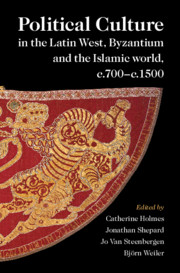 Political Culture in the Latin West, Byzantium and the Islamic World, c.700–c.1500
Political Culture in the Latin West, Byzantium and the Islamic World, c.700–c.1500 Book contents
- Political Culture in the Latin West, Byzantium and the Islamic World, c.700–c.1500
- Political Culture in the Latin West, Byzantium and the Islamic World, c.700–c.1500
- Copyright page
- Contents
- Figures and Maps
- Contributors
- Preface and Acknowledgements
- Abbreviations
- General Maps
- 1 Political Culture in Three Spheres
- 2 Reflections on Political Culture in Three Spheres
- Part I Sources
- Part II Historical Contexts
- Part III Norms, Values and Their Propagation
- Part IV Practice and Organisation
- 13 The Latin West
- 14 Byzantium
- 15 The Islamic World
- Part V Conclusions
- Appendix
- Glossary
- Index
15 - The Islamic World
Nomads, Urban Elites and Courts in Competition
from Part IV - Practice and Organisation
Published online by Cambridge University Press: 11 August 2021
- Political Culture in the Latin West, Byzantium and the Islamic World, c.700–c.1500
- Political Culture in the Latin West, Byzantium and the Islamic World, c.700–c.1500
- Copyright page
- Contents
- Figures and Maps
- Contributors
- Preface and Acknowledgements
- Abbreviations
- General Maps
- 1 Political Culture in Three Spheres
- 2 Reflections on Political Culture in Three Spheres
- Part I Sources
- Part II Historical Contexts
- Part III Norms, Values and Their Propagation
- Part IV Practice and Organisation
- 13 The Latin West
- 14 Byzantium
- 15 The Islamic World
- Part V Conclusions
- Appendix
- Glossary
- Index
Summary
The early Islamic empire may have been the largest by land, but military reach should not be mistaken for highly centralised administrative structures: these only developed as the empire fragmented but were replicated in the tenth-century successor states, where the position of vizier gained increasing political influence. Nor should imperial success be mistaken for a stable elite, as newcomers – notably court scribes and religious scholars – challenged the military. The Abbasid caliphs’ fortunes varied with their military, fiscal and administrative structures, but they remained necessary legitimisers of other political structures, too sacred to depose. However, it was the ʿulamaʾ who established and elaborated ideological structures that long outlasted the first Muslim empires. After the mid-thirteenth-century upheavals, the ad hoc reach of Turco-Mongol and Arabo-Berber trans-regional leaderships formed an ‘archipelago’ in a ‘sea of semi-independent regions’ characterised by violent, volatile and complex power relationships. Eventual stabilisation ended centuries of political turbulence, centred around the great early modern empires of the Ottomans, Safavids and Mughals.
- Type
- Chapter
- Information
- Political Culture in the Latin West, Byzantium and the Islamic World, c.700–c.1500A Framework for Comparing Three Spheres, pp. 456 - 486Publisher: Cambridge University PressPrint publication year: 2021
